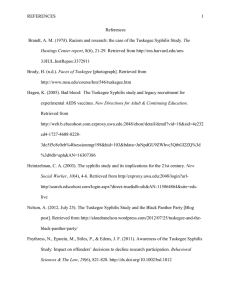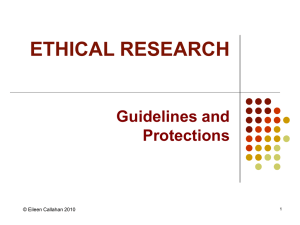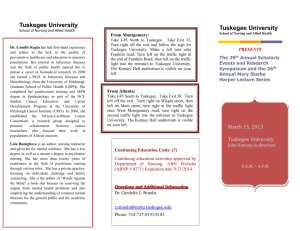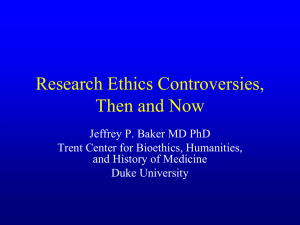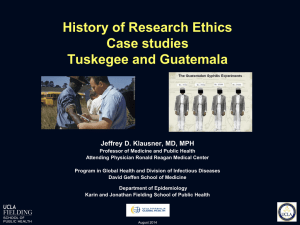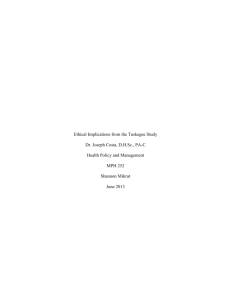The Tuskegee Syphilis Study: A Critical Examination of a Breach in
advertisement
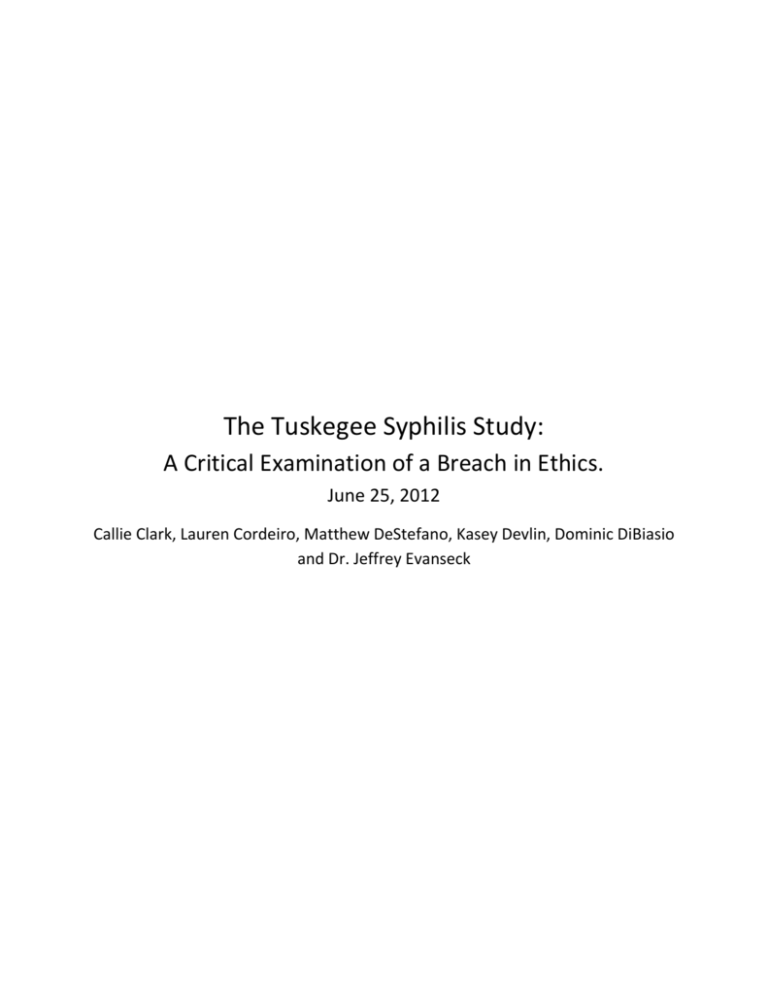
The Tuskegee Syphilis Study: A Critical Examination of a Breach in Ethics. June 25, 2012 Callie Clark, Lauren Cordeiro, Matthew DeStefano, Kasey Devlin, Dominic DiBiasio and Dr. Jeffrey Evanseck The Tuskegee Syphilis Study began in 1932 and didn’t conclude until 1972 in Macon County, Alabama. The US Public Health Service along with the Tuskegee Institute recruited 600 black men and their families to participate in this study. These men were already infected with Syphilis but were unaware of its existence. The experiment was originally designed for the patients to go without treatment for six to nine months. When that time was concluded each patient would be treated accordingly. However the design quickly changed. A modification was added to eliminate treatment and prolong the experiment for years or until death. These patients were not told they had syphilis but that they were being treated for bad blood. The doctors had promised free examinations, treatment, food and burial insurance but the doctors had no intentions of treating their patients. They wanted to observe the effects of syphilis on the African American male. The life cycle of syphilis occurs in three stages. . The initial time between infection and the first symptoms can range from ten to ninety day with an average of twenty-one. The first stage typically appears as a single sore but can appear as multiple. This sore is also known as a chancre. These chancres are small, round and painless. They will heal themselves within three to six weeks and if not medicated the infection will proceed to the second stage. The first stage is the most undertreated of the stages. The second stage is characterized by a skin rash and mucous membrane lesions. This characteristic rash can appear as a rough, red or reddish brown spots on the palms of the hands or the soles of the feet. However, this rash can be located on other parts of the body and resemble other diseases. There are other symptoms associated with the second stage. These can include fever, swollen lymph glands, sore throat, patchy hair loss, headaches, weight loss, muscle aches and fatigue. These symptoms will also resolve without treatment but will then progress to the third and late stages of the disease. This latent stage of syphilis can have no symptoms for ten to twenty years after the infection is initially acquired. This can cause damage to the internal organs, including the eyes, brain, nerves, liver, bones, heart, blood vessels and joints. This damage can lead to difficulty coordinating muscle movements, numbness, paralysis, gradual blindness and dementia. These complications can be serious enough to lead to death. All three stages can be treated by shots of penicillin. In 1945, Penicillin was discovered as an acceptable treatment for Syphilis but was never administered to the patients. This entire study violated the four ethical guidelines of the medical field. The first is the lack of beneficence. This study laced actions to benefit others; the patients were only becoming sicker and many died. The second is the lack of nonmaleficence. Nonmaleficence means to do no harm and this study only caused harm to its patients. The third is the lack of respect for autonomy. The patients were not informed of their treatment to act as individuals without outside influence. The fourth is the lack of justice. This study was not fair and reasonable. The patients were not being treated as human beings. In a statement by Dr. John Heller, the director of Public Health Service’s Division of Venereal Diseases stated “The men's status did not warrant ethical debate. They were subjects, not patients; clinical material, not sick people.” Finally, in 1972 the study was ended. In 1973, the patients finally received some justice. The NAACP filed a class action lawsuit in which the U.S. government paid $9 million and provided medical treatment to surviving participants and their families. In 1997, five of the eight surviving patients attended the ceremony in which President Bill Clinton issued a public apology. Now forty years after the study concluded there is a strong emphasis on ethical behavior and the education of ethics so history will not be repeated. Works Cited Brandt, Allan M. "Racism and Research: The Case of the Tuskegee Syphilis Study." Hastings Center Magazine, (1978): 1-13. SciFinder. Web. 9 June 2012. Brown, Ronald H., Jean L. Harris, Seward Hiltner, Jeanne C. Sinkford, Fred Speaker, and Barney H. Weeks. "Tuskegee Syphilis Study Ad Hoc Advisory Panel." (1973): 5-13. SciFinder. Web. 9 June 2012. "How Tuskegee Changed Research Practices." Centers for Disease Control and Prevention. Centers for Disease Control and Prevention, 15 June 2011. Web. 13 June 2012. <http://www.cdc.gov/tuskegee/after.htm>. "Remarks by the President in apology for study done in Tuskegee". Office of the Press Secretary, The White House. 1997-05-16. http://clinton4.nara.gov/textonly/New/Remarks/Fri/19970516-898.html. Retrieved 200909-06. "Tuskegee Study - Timeline". NCHHSTP. CDC. 2008-06-25. http://www.cdc.gov/tuskegee/timeline.htm. Retrieved 2008-12-04. White, Robert M. "Misinformation and Misbeliefs in the Tuskegee Study of Untreated Syphilis Fuel Mistrust in the Healthcare System." Journal of the National Medical Association 97.11 (2005): 1566-573. SciFinder. Web. 9 June 2012. <http://nmanet.org/Conferences_National.htm>.
